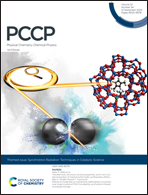Plasma-chemical promotion of catalysis for CH4 dry reforming: unveiling plasma-enabled reaction mechanisms†
Abstract
A kinetic study revealed that a Ni/Al2O3 catalyst exhibited a drastic increase in CH4 and CO2 conversion under nonthermal plasma when lanthanum was added to the Ni/Al2O3 catalyst as a promoter. For a better fundamental understanding of the plasma and catalyst interfacial phenomena, we employed in situ diffuse reflectance infrared Fourier transform spectroscopy (DRIFTS) under plasma-on conditions to elucidate the nonthermal plasma-enabled reaction enhancement mechanisms. Compared with thermal catalysis, plasma-activated CO2 shows a 1.7-fold enhancement for bidentate (1560 and 1290 cm−1) and monodentate carbonate (1425 and 1345 cm−1) formation on La. Moreover, new peaks of bicarbonate (1655 cm−1) and bridge carbonate (1720 cm−1) were formed due to nonthermal plasma interactions. CO2-TPD study after thermal- and plasma-activated CO2 treatment further confirmed that plasma-activated CO2 enhances bidentate and monodentate carbonate generation with a 1.5-fold promotion at high temperature (500 °C). XRD and EDS analyses suggest that atomic-scale interaction between CO2–La and CHx–Ni is possible over the complex La–Ni–Al oxide; vibrationally excited CO2-induced carbonates provide the key to enhancing the overall performance of CH4 dry reforming at low temperature.



 Please wait while we load your content...
Please wait while we load your content...